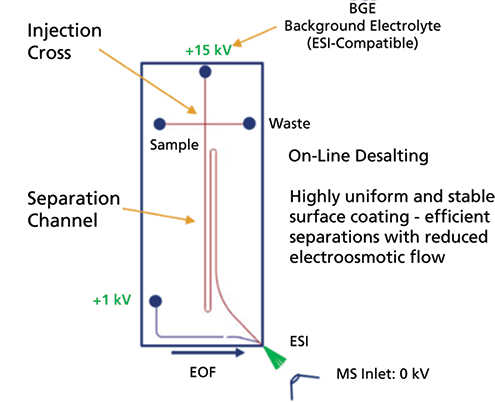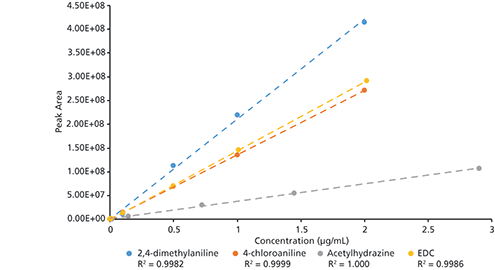Quantitation of Mutagenic Impurities in APIs Using a Platform Chip-Based CE–MS Method
The ZipChip CE-ESI interface was evaluated for suitability as a platform approach for quantitation of MIs in API.
Peer-Reviewed
Submitted: January 2, 2019
Accepted: February 18, 2019
Abstract
Highly sensitive, selective, and robust methods are required for mutagenic impurity (MI) quantitation in APIs to ensure patient safety. Typically, product-specific gas chromatography or liquid chromatography methods are used, which require considerable resources to develop and validate. The ZipChip CE-ESI interface was evaluated for suitability as a platform approach for quantitation of MIs in API. The linearity, sensitivity, precision (repeatability), and accuracy were assessed for 1-ethyl-3-(3-(dimethylamino)propyl)carbodiimide, 2,4-dimethylaniline, 4-chloroaniline, and acetylhydrazine in the presence of either carfilzomib or acetaminophen using the peptide reagents and method conditions provided by the vendor. The method was found to be linear from 1 ng/mL to 20 µg/mL (R2 ≥ 0.998). At 10 ng/mL, the peak area precision (repeatability) and average recovery were found to be at least ≤ 8.9% (RSD) and 84%, respectively, which is similar to what would be achievable by more common quantitative MI methods. Additionally, a one-minute method was achievable with the default peptide conditions using an HS chip. These initial results indicate that a platform method for quantitation of ionizable MIs which are positively charged at pH 2.4 is possible, which can significantly reduce the development time required for assessing MIs.
VADIML - STOCK.ADOBE.COM

The control of mutagenic impurities (MIs) in pharmaceutical drug substances has been a focus of health authorities and the pharmaceutical industry for several years. Mutagenic impurities are compounds that are DNA reactive and have the potential to directly cause DNA damage, leading to mutations, and potentially result in cancer (1–4). The control of MIs within the API manufacturing process, therefore, is crucial in ensuring patient safety. MIs are derived either from reagents used in the synthesis of the API, side products, or degradants (5–10). MI control in drug substances and drug products is governed by International Council for Harmonization (ICH) guidelines such as ICH M7 (R1) and ICH S9 (11–12). Due to the severity of the human response to these impurities, MIs require much tighter control than non-mutagenic impurities, thus requiring highly sensitive analytical methods.
A highly sensitive, selective, and robust method for accurate MI quantitation is required (5, 9, 13, 14, 15). Challenges associated with development of MI quantitation methods include the low limit of quantitation (LOQ) required, matrix effects, and the diverse physiochemical properties of the MIs (16–17). For example, typically a gas chromatography (GC) or liquid chromatography (LC) method is developed for each API, and the typical acquisition time for these methods is approximately 20 minutes. Additionally, derivatization and the use of less common detectors are often required to achieve the required sensitivity. Because of this, development of these methods is often quite lengthy. In early development, the application of risk assessment to demonstrate adequate control of MIs is recommended, but many times a method is needed to support this justification (18).
Taking these factors into account, it is highly desirable to have a platform method that is suitable across APIs and for multiple MIs. While approaches for systematic method development have been proposed, these approaches still require a product-specific method to be developed (1, 15, 19, 20). Evaluation of the potential for quantitation of MIs in APIs using a microfluidic capillary electrophoresis (CE) separation with on-chip electrospray ionization coupled to a mass spectrometer (Q-Exactive,Thermo Scientific) has been evaluated for the potential to provide a rapid platform method.
Materials and methods
Reagents, standards, and samples. The pre-mixed diluent (Peptide Mix Diluent, 908 Devices Inc.) was used as supplied. 2,4-Dimethylamine, acetylhydrazine, 1-ethyl-3-(3-(dimethylamino)propyl)carbodiimide (EDC), and acetaminophen were purchased from Sigma Aldrich. 4-Chloroaniline was purchased from TCI America. Carfilzomib was supplied by Amgen Inc.
Sample preparation. All standards were diluted with the pre-mixed diluent. For each MI, seven linearity solutions were prepared from 1 ng/mL to 2 µg/mL from a stock standard at 10 µg/mL. The linearity standards included 1 ng/mL, 5 ng/mL, 10 ng/mL, 100 ng/mL, 500 ng/mL, 1 µg/mL, and 2 µg/mL (3 µg/mL for acetylhydrazine). The LOQ and working standard solutions were prepared at 1 ng/mL and 10 ng/mL, respectively, from the stock standard.
The accuracy samples were prepared in triplicate for each MI by diluting a sample preparation of either acetaminophen or carfilzomib with each MI working standard to make a 10 mg/mL sample concentration with 10 ng/mL (1 ppm) of the MI. Carfilzomib was used as the sample for EDC and acetylhydrazine recovery, while acetaminophen was used as the sample for 2,4-dimethylaniline and 4-chloroaniline recovery. The recovery was calculated by assessing the peak area obtained for each sample against the standard peak area.
Separation and detection conditions. MI standards were separated from the API (acetaminophen or carfilzomib) with a interface (908 Devices Inc., ZipChip). The separation was performed using an HR chip (Figure 1, 22-cm long separation channel), the peptide background electrolyte, and the default ZipChip metabolite separation settings (1000 V/cm; 4.12 nL injection volume) without pressure assist. For the one-minute method, an HS chip (10-cm long separation channel) was utilized with pressure assist enabled for 0.5 minutes. Mass spectrometer (MS) data were collected with a mass spectrometer (Thermo Q-Exactive Biopharma) (resolution: 17,500; ACG target: 1e6; inlet capillary temperature: 200 ºC; microscans: 1; maximum ion inject time: 20 ms). MS spectra were collected using single ion monitoring (SIM) mode for the m/z of the MI ion of interest. For each MI, specificity, sensitivity, linearity, precision (repeatability), and recovery were assessed.
Figure 1: Schematic of ZipChip. EOF is electroosmotic flow. ESI is electrospray ionization. MS is mass spectrometry. (All figures courtesy of the authors)

Results and discussion
For all studies discussed, platform method conditions, background electrolyte, and sample dilution procedures were followed as provided by the manufacturer. For most of the work, an HR chip was used to allow multiple analyte types to be run within the same sample injection sequence, but the HR chip was not required to achieve good performance for MI analysis. Due to the use of the HR chip, the analysis time was longer than necessary, but this was considered acceptable for method assessment.
Method performance. The sensitivity, linearity, precision (repeatability), and accuracy were assessed for EDC, 2,4-dimethylaniline, 4-chloroaniline, and acetylhydrazine. These results are shown to illustrate the applicability of the method, but additional experiments would need to be performed for a late-phase method validation. An example extracted ion electropherogram for each MI assessed is shown in Figure 2. The selectivity, migration time, and peak shape were suitable for all MIs tested without requiring method development. For each of these MIs, the method was found to be linear from 1 ng/mL (0.1 ppm) to 2 µg/mL (200 ppm) (R2 ≥ 0.998), as shown in Figure 3. At 10 ng/mL (1 ppm), the peak area precision was found to be ≤ 8.9% (relative standard deviation [RSD]), the migration time precision was ≤ 3.1% (RSD), and the average recovery was ≥ 84% (see Table I). For the LOQ solution (1 ng/mL), the peak area precision was ≤ 14.1% (RSD). The results provided by this platform chip-based CE–MS method are similar to what would be achievable by more common MI methods but were achieved with no method development. These results indicate that a rapid platform method for quantitation of ionizable MIs is possible with this chip-based CE-MS method.
Figure 2: Example extracted ion electropherogram for 10 ng/mL solutions of a) 1-ethyl-3-(3-(dimethylamino)propyl)carbodiimide (EDC), b) 2,4-dimethylaniline (2,4-DMA), c) 4-chloroaniline (4-CA), and d) acetylhydrazine (AH) with the HR chip and default peptide separation settings.

Click to Enlarge

While good method performance was achievable, there were some initial challenges encountered when using this technology. When a long sample injection sequence (approximately 50 injections) was queued, sporadic injections would show no response. Sample preparation was not found to be the root cause. Rather, it is likely due to improper priming of the sample delivery line prior to analysis. While void injections will cause problems if performed in a regulated environment, the technology was found to be suitable for development. Additionally, it is expected that as the robustness of chip technology advances, this methodology would be acceptable in a regulated environment.
Figure 3: Linearity of mutagenic impurities from 1 to 2000 ng/mL. EDC is 1-ethyl-3-(3-(dimethylamino)propyl)carbodiimide.

One-minute method. A significant advantage of the platform chip-based CE–MS method is a shorter run time. Typical MI methods are approximately 20 minutes including re-equilibration. The vendor-provided peptide background electrolyte and CE–MS parameters were found to produce a one-minute method for the separation of MIs from the API using the HS chip (Figure 4). The LOQ for the one-minute method was the same (1 ng/mL) as that achieved with the five-minute method.
Figure 4: Example extracted ion electropherogram for one-minute quantitation method for 10 ng/mL solutions of a) 1-ethyl-3-(3-(dimethylamino)propyl)carbodiimide (EDC), b) 2,4-dimethylaniline (2,4-DMA), c) 4-chloroaniline (4-CA), and d) acetylhydrazine (AH) with the HS chip, default peptide separation settings, and pressure assist.

The reduction in the method development time and analysis time using the platform CE–MS method highlights the utility of this system, particularly in early development when time savings are critical. While this technique is suitable for analytes positively charged at pH 2.4, it is not suitable for uncharged or negatively charged analytes in this pH range as migration will not occur. Additionally, it should be ensured that accurate quantitation in the presence of the API of interest is obtained as the studies performed have not been exhaustive.
Conclusion
A platform chip-based CE–MS method was developed for accurate quantitation of ionizable MIs present in APIs. The method was found to be comparable to more typical methods, and the analysis time and method development time were significantly reduced. Furthermore, this platform methodology eliminates the need for product-specific method development.
References
1. A. Kumar, K. Zhang, and L. Wigman, LCGC North America 33 (5) 344-359 (2015).
2. D.J. Snodin and S.D. McCrossen, Regul. Toxicol. Pharmacol. 67 (2) 299-316 (2013).
3. D.J. Snodin and D.P. Elder, Pharm. Outsourc. 13 (3) (2012).
4. D.J. Snodin and D.P. Elder, Pharm. Outsourc. 11 (5) (2012).
5. M.H. Kleinman, et. al., Org. Proc. Res. Dev. 19 (11) 1447-1457 (2015).
6. N. Lapanja, et. al., Org. Proc. Res. Dev. 19 (11) 1524-1530 (2015).
7. M. McLaughlin, et. al., Org. Proc. Res. Dev. 19 (11) 1531-1535 (2015).
8. S.M. Galloway, et. al., Reg. Tox. Pharm. 66 (3) 326–335 (2013).
9. V. Gangadhar, Y.P. Saradhi, and R. Rajavikram, Pharma. Tech. 5 (2011).
10. H. Wilcox, The Challenges of Detecting Mutagenic Impurities, Whitepaper, EAG.com, www.eag.com/resources/whitepapers/detecting-mutagenic-impurities/.
11. ICH, M7 (R1), Assessment and Control of DNA Reactive (Mutagenic) Impurities in Pharmaceuticals to Limit Potential Carcinogenic Risk, Step 4 version (ICH, 2017).
12. ICH, S9, Nonclinical Evaluation for Anticancer Pharmaceuticals, Step 4 version (ICH 2009).
13. L. Bray, et. al., Sci. Pharm. 83 (2) 269–278 (2015).
14. J. Simeone, P. Hong, and P.R. McConville, Chrom. Today, May/June (2017).
15. P. Borman et al., Journal of Pharmaceutical and Biomedical Analysis, 48 (4) 1082-1089 (2008).
16. A. Teasdale and D.P. Elder, Trends Anal. Chem. 101 66-84 (2018).
17. A. Baker, “Development of a Strategy for Analysis of Genotoxic Impurities,” in Genotoxic Impurities, Strategies for Identification and Control 281-304 (John Wiley & Sons, Hoboken, NJ, 2011).
18. A. Teasdale, et al., Org Process Res Dev 17 (2) 221-230 (2013).
19. D.Q. Liu and A.S. Kord, Trends. Anal. Chem. 49 July/August, 108-117 (2013).
20. F. David, et. al., “Strategic Approaches to the Chromatographic Analysis of Genotoxic Impurities,” in Genotoxic Impurities, Strategies for Identification and Control, 305 -350 (John Wiley & Sons, Hoboken, NJ, 2011).
Article Details
Pharmaceutical Technology
Vol. 43, No. 8
August 2019
Pages: 32-35
Citation
When referring to this article, please cite it as J. Bao et al., "Quantitation of Mutagenic Impurities in APIs Using a Platform Chip-Based CE–MS Method," Pharmaceutical Technology 43 (8) 2019.
